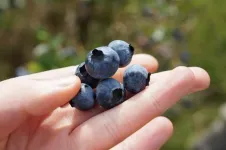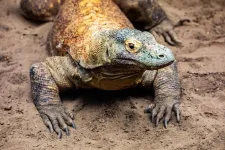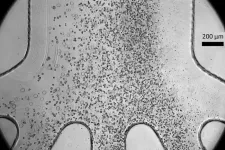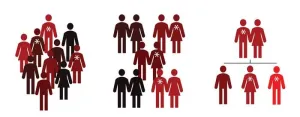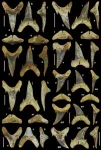(Press-News.org) An international team of scientists has created a tool that can aid in increasing climate awareness and climate action globally by highlighting messaging themes shown to be effective through experimental research.
The web-based tool, and the methods undergirding its creation, appears in the journal Science Advances.
The tool stems from a study involving nearly 250 researchers that drew more than 59,000 participants from 63 countries, including Algeria, China, Denmark, Germany, Israel, Japan, New Zealand, Peru, and the United States.
“We tested the effectiveness of different messages aimed at addressing climate change and created a tool that can be deployed by both lawmakers and practitioners to generate support for climate policy or to encourage action,” says Madalina Vlasceanu, an assistant professor in New York University’s Department of Psychology and the paper’s lead author.
The tool, which the researchers describe as a “Climate Intervention Webapp,” takes into account an array of targeted audiences in the studied countries, ranging from nationality and political ideology to age, gender, education, and income level.
"To maximize their impact, policymakers and advocates can assess which messaging is most promising for their publics,” adds paper author Kimberly Doell, a senior scientist at the University of Vienna who led the project with Vlasceanu.
This video outlines the work and its significance.
Previous studies have examined the effectiveness of intervention strategies aimed at boosting sustainable intentions and behaviors, such as recycling, public transportation use, and household energy saving. But these have focused on singular private mitigation actions rather than on a broad array of climate-friendly activities and support for systemic solutions. In addition, earlier work has generally centered on western, industrialized nations, raising questions about the broader applicability of these findings.
Among the messages the authors of the new paper tested presented the consequences of climate change in a “doom and gloom” style (e.g., “Climate change poses a serious threat to humanity.”). Another featured examples of successful climate actions people took in the past. An additional intervention asked participants to write a letter to a future generation member outlining what climate actions they are undertaking today to make the planet livable in 2055. Others included emphasizing the scientific consensus on the facts and framing climate action as either a patriotic or a popular choice.
To gauge the effectiveness of these interventions, the paper’s authors tested participants’ support for several climate-related views, policies, and actions (e.g., “Climate change poses a serious threat to humanity,” “I support raising carbon taxes on gas/fossil fuels/coal,” participation in a tree-planting initiative). Finally, the paper’s authors gauged the desire of participants to share climate-mitigation information on social media: “Did you know that removing meat and dairy for only two out of three meals per day could decrease food-related carbon emissions by 60%?” The data were collected between July 2022 and May 2023.
Overall, while responses varied significantly among geographic location and participants’ demographics and beliefs, 86% recognized the dangers posed by climate change and more than 70% backed systemic/collective action addressing climate change.
“These responses reveal a global consensus regarding the dangers posed by climate change and the importance of enacting climate mitigation at the systemic level,” observes Jay Van Bavel, a professor of psychology at NYU and one of the paper’s authors. “It’s important that people realize that there is an overwhelming global consensus on this issue.”
However, there were notable differences among countries in response to the same messages or interventions. For example:
Emphasizing scientific consensus on climate change (i.e., “Ninety-nine percent of expert climate change scientists agree that the Earth is warming, and climate change is happening, mainly because of human activity.”) increased support for climate-friendly policies by 9% in Romania, but decreased such support by 5% in Canada.
Asking participants to write a letter to a socially close child, as a member of the future generation, had the following effects:
* The intervention increased climate policy support in the following countries: the United States (10%), Brazil (10%), Ghana (8%), Russia (7%), and Nigeria (5%).
* The intervention decreased policy support slightly in the UAE and Serbia (3%) as well as in India (2%).
Among participants who used social media, willingness to share climate change information on these platforms generally increased in response to all interventions tested. Notably, the largest gains occurred after participants read facts about the negative impacts of climate change—a “gloom and doom” style of messaging. After hearing these messages, participants were 12% more likely to share pro-environmental messages on social media.
Conversely, no intervention increased support for the tested action: a tree-planting initiative. In fact, some interventions decreased the likelihood of expressing willingness to undertake this individual-level action.
Taken together, the findings shed new light on the effectiveness of climate messaging. Some activists have argued in favor of a “doom-and-gloom” messaging style as a way to encourage action. Others, however, have said that such messaging may have no impact on behavior, or worse, that it may depress and demoralize the public into inaction.
The new study offers support for both approaches—depending on the objective. While “doom and gloom” messaging was effective at stimulating sharing on social media, which the researchers acknowledge is a low-effort activity, it decreased support for tree-planting—a more labor-intensive task. Moreover, this messaging decreased policy support among study participants who were climate-change skeptics.
“Our results illuminate the impact of messaging aimed at achieving specific objectives,” concludes Vlasceanu. “At the same time, these findings make clear that effective outreach depends on peoples’ pre-existing belief in climate change, showing that policymakers and advocates need to tailor their outreach to the characteristics of their audience.”
# # #
END
Psychology study unearths ways to bolster global climate awareness and climate action
Global research team’s work spurs creation of “behavioral science” tool for policymakers and advocacy groups
2024-02-07
ELSE PRESS RELEASES FROM THIS DATE:
Scientists reveal why blueberries are blue
2024-02-07
Tiny external structures in the wax coating of blueberries give them their blue colour, researchers at the University of Bristol can reveal.
This applies to lots of fruits that are the same colour including damsons, sloes and juniper berries.
In the study, published today in Science Advances, researchers show why blueberries are blue despite the dark red colour of the pigments in the fruit skin. Their blue colour is instead provided by a layer of wax that surrounds the fruit which is made up of miniature structures that scatter blue and UV light. This gives blueberries their blue appearance to humans and blue-UV to birds. The chromatic blue-UV reflectance ...
McMaster and ALK researchers discover new cell that remembers allergies
2024-02-07
Researchers with McMaster University and Denmark-based pharmaceutical company ALK-Abello A/S have made a groundbreaking discovery: a new cell that remembers allergies.
The discovery gives scientists and researchers a new target in treating allergies and could lead to new therapeutics. The research, published in Science Translational Medicine on Feb. 7, 2024, coins the brand-new cell as a type-2 memory B cell (MBC2).
“We’ve discovered a type of memory B cell that had unique characteristics and a unique gene ...
England’s oldest became frailer during austerity, study suggests
2024-02-07
The speed at which England’s oldest adults became frailer accelerated during the UK Government’s era of austerity politics, according to a new study.
Researchers say that the rate of frailty in people aged 85 and over in England increased 50 per cent faster per year between 2012 and 2018 compared with the preceding eight years.
The impact of frailty – a decline in a person’s mental and physical resilience to illness and injury – on the oldest in society must be considered should any new austerity measures be introduced, experts warn.
The study, led by researchers from the University of Edinburgh’s ...
Exceptionally rapid tooth development and ontogenetic changes in the feeding apparatus of the Komodo dragon
2024-02-07
Tea Maho and Robert R. Reisz
University of Toronto Mississauga
Kilat, the largest living lizard at the Toronto Metro Zoo, like other members of his species (Varanus komodoensis), truly deserves to be called the Komodo Dragon! Its impressive size and the way it looks at you and tracks your every move makes you realize that it is an apex predator, not unlike a ferocious theropod dinosaur. So, it is not surprising when you look around at his enclosure to find that there are shed teeth sparkling on the ground, a common find when ...
Scientists develop a low-cost device to make cell therapy safer
2024-02-07
CAMBRIDGE, MA – A tiny device built by scientists at MIT and the Singapore-MIT Alliance for Research and Technology could be used to improve the safety and effectiveness of cell therapy treatments for patients suffering from spinal cord injuries.
In cell therapy, clinicians create what are known as induced pluripotent stem cells by reprogramming some skin or blood cells taken from a patient. To treat a spinal cord injury, they would coax these pluripotent stem cells to become progenitor cells, which are destined to differentiate into spinal cord cells. These progenitors are then transplanted back into ...
Getting to know the ‘ghost’ inside batteries
2024-02-07
An Argonne team developing materials for solid-state batteries took an unexpected detour to investigate tiny short-circuits known as soft-shorts. Their insights will benefit battery researchers around the world.
Researchers at the U.S. Department of Energy’s (DOE) Argonne National Laboratory have shed important new light on what the early signs of battery failure look like. Their study — which relates to a condition called soft-shorts — provides the research community with valuable knowledge and methods to design better electric vehicle (EV) batteries.
The Argonne team’s research focused on all-solid batteries with anodes (negative electrodes) ...
Predicting neurodevelopmental disease in children from parent’s traits
2024-02-07
UNIVERSITY PARK, Pa. — Predicting the trajectory of neurodevelopmental and psychiatric disorders like autism or schizophrenia is difficult because they can be influenced by many different genetic and environmental factors. A new study, led by Penn State researchers, demonstrates that evaluating parents for their manifestation of traits of these disorders — and related diseases like depression and anxiety — may provide a more accurate method of predicting the prevalence, and potentially severity, of the disorders in affected children than screening for genetic variants alone. This is likely due, at least in part, to genetic variants the parents transmit to the ...
New species of 65 million year old fossil shark discovered in Alabama, USA
2024-02-07
Birmingham, AL (February 7, 2024) – Today, a team of scientists is pleased to announce the discovery of a new fossil shark species from Alabama, USA. The team is led by Jun Ebersole, Director of Collections, McWane Science Center, Birmingham, AL, David Cicimurri, Curator of Natural History, South Carolina State Museum in Columbia, and T. Lynn Harrell, Jr., Paleontologist and Fossil Collections Curator at the Geological Survey of Alabama in Tuscaloosa.
The shark is a new species of Palaeohypotodus (pronounced pale-ee-oh-hype-oh-toe-duss), which means “ancient small-eared tooth,” in reference to the small needle-like fangs present on the sides of the teeth. It has ...
Time to treatment with intravenous thrombolysis before thrombectomy and functional outcomes in acute ischemic stroke
2024-02-07
About The Study: In patients presenting at thrombectomy-capable stroke centers, the benefit associated with intravenous thrombolysis (IVT) plus thrombectomy versus thrombectomy alone was time dependent and statistically significant only if the time from symptom onset to expected administration of IVT was short in this individual participant data meta-analysis (n = 2,313) of six randomized clinical trials.
Authors: Johannes Kaesmacher, M.D., Ph.D., of the University of Bern in Bern, Switzerland, is the corresponding author.
To access the embargoed study: Visit ...
Many hookah manufacturers have not complied with FDA-mandated nicotine warning labels
2024-02-07
FOR IMMEDIATE RELEASE
February 7, 2024
Contact:
Jillian McKoy, jpmckoy@bu.edu
Michael Saunders, msaunder@bu.edu
##
Many Hookah Manufacturers Have Not Complied with FDA-Mandated Nicotine Warning Labels
Only half of the hookah packages assessed in a new study included the required nicotine warnings, two years after this federal regulation was implemented to alert consumers about the health risks of nicotine addiction.
Since August 2018, the US Food & Drug Administration has mandated that all hookah (also known as waterpipe tobacco or shisha) manufacturers include a nicotine warning ...
LAST 30 PRESS RELEASES:
Why nail-biting, procrastination and other self-sabotaging behaviors are rooted in survival instincts
Regional variations in mechanical properties of porcine leptomeninges
Artificial empathy in therapy and healthcare: advancements in interpersonal interaction technologies
Why some brains switch gears more efficiently than others
UVA’s Jundong Li wins ICDM’S 2025 Tao Li Award for data mining, machine learning
UVA’s low-power, high-performance computer power player Mircea Stan earns National Academy of Inventors fellowship
Not playing by the rules: USU researcher explores filamentous algae dynamics in rivers
Do our body clocks influence our risk of dementia?
Anthropologists offer new evidence of bipedalism in long-debated fossil discovery
Safer receipt paper from wood
Dosage-sensitive genes suggest no whole-genome duplications in ancestral angiosperm
First ancient human herpesvirus genomes document their deep history with humans
Why Some Bacteria Survive Antibiotics and How to Stop Them - New study reveals that bacteria can survive antibiotic treatment through two fundamentally different “shutdown modes”
UCLA study links scar healing to dangerous placenta condition
CHANGE-seq-BE finds off-target changes in the genome from base editors
The Journal of Nuclear Medicine Ahead-of-Print Tip Sheet: January 2, 2026
Delayed or absent first dose of measles, mumps, and rubella vaccination
Trends in US preterm birth rates by household income and race and ethnicity
Study identifies potential biomarker linked to progression and brain inflammation in multiple sclerosis
Many mothers in Norway do not show up for postnatal check-ups
Researchers want to find out why quick clay is so unstable
Superradiant spins show teamwork at the quantum scale
Cleveland Clinic Research links tumor bacteria to immunotherapy resistance in head and neck cancer
First Editorial of 2026: Resisting AI slop
Joint ground- and space-based observations reveal Saturn-mass rogue planet
Inheritable genetic variant offers protection against blood cancer risk and progression
Pigs settled Pacific islands alongside early human voyagers
A Coral reef’s daily pulse reshapes microbes in surrounding waters
EAST Tokamak experiments exceed plasma density limit, offering new approach to fusion ignition
Groundbreaking discovery reveals Africa’s oldest cremation pyre and complex ritual practices
[Press-News.org] Psychology study unearths ways to bolster global climate awareness and climate actionGlobal research team’s work spurs creation of “behavioral science” tool for policymakers and advocacy groups
